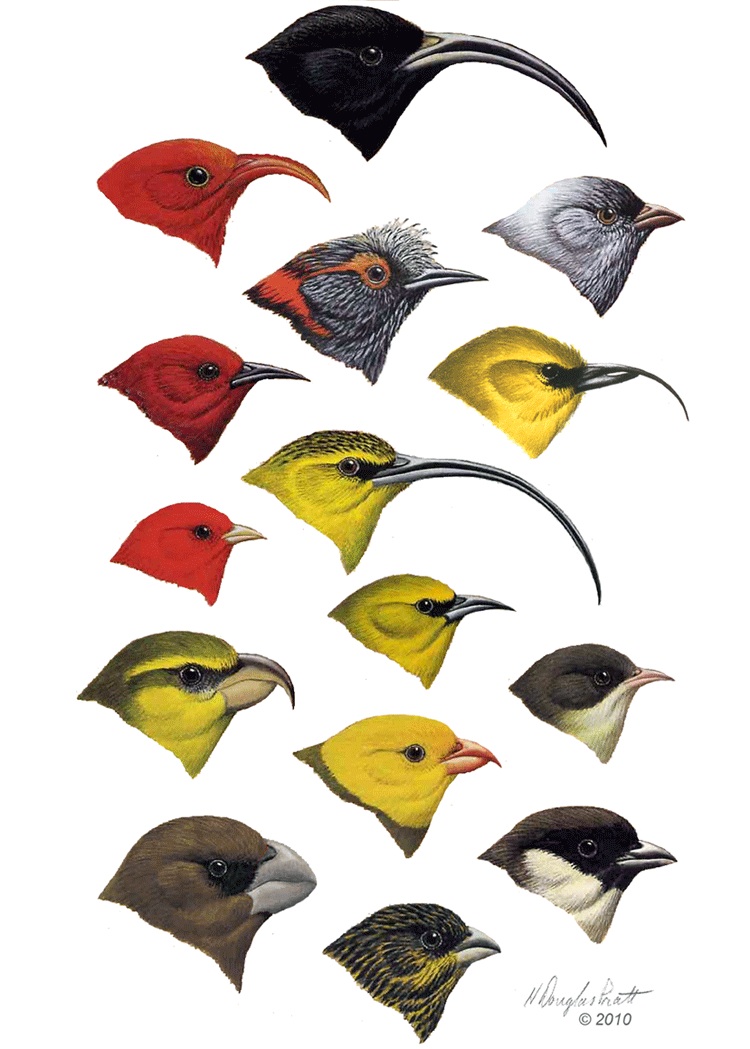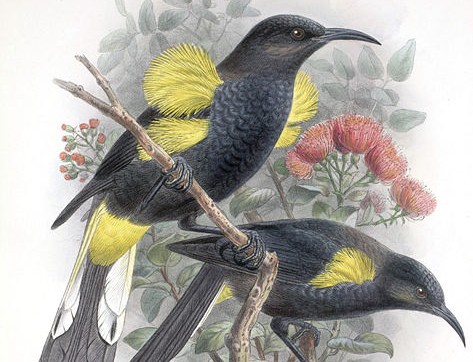Unit 3: Rain Forest Birds: A Study In Adaptation
Rain Forest » Unit 3: Rain Forest Birds: A Study In Adaptation
Overview
Between the native species living today and the fossil record still being unearthed, there is plenty of evidence for the remarkable diversity of bird life that evolved on the Hawaiian Islands. By looking at rain forest birds, students explore how that diversity of life may have evolved, including the process of adaptive radiation. They also learn about the effects of human pressure on species survival and ongoing threats to native bird species, and they conduct independent research projects on native rain forest birds.
Length of Entire Unit
Three class periods, plus optional research and presentation time.
Subject
Native birds. Adaptive radiation. Evolution.
Importance
Surviving native bird species and the growing fossil record present plenty of evidence for the remarkable diversity of bird life that evolved on the Hawaiian islands. But human pressures have altered and continue to alter the natural dynamics of evolution.
Unit Focus Questions
- What is adaptive radiation and how has this process influenced the evolution of species in Hawaiian rain forests?
- What are historic and current threats to native rain forest bird species?
Enrichment Ideas
- Research and accurately color line drawings of native rain forest birds. Use the Forest Jewels of Hawaiʻi coloring book (Hawaiʻi Department of Land and Natural Resources, Division of Forestry and Wildlife, Honolulu, 1996) along with the images of birds in Arthur C. Medeiros, and Lloyd L. Loope, Rare Animals and Plants of Haleakalā National Park, Hawaiʻi Natural History Association, Hawai’i National Park, Hawaiÿi, 1994.
- Produce original drawings, watercolor or oil paintings, or other artistic and accurate representations of Hawaiian rain forest birds.
- Design a bird to fit different types of food sources. Collect samples or drawings of potential food sources for birds and draw or construct a model of a bird head and beak (or an entire bird) that is adapted to the food source(s).
Potential food sources:- Flowers of different sizes and shapes,
- Seeds and nuts of different sizes and shapes,
- Tree branches or trunks with different types of bark (look for variations such as smooth surfaces on which insects crawl, crevices that shelter insects, or different thicknesses of bark that birds would peel or pry off to reach larvae burrowed underneath),
- Fruits of various sizes, shapes, and textures, and
- Insects of different sizes and shapes that have different life histories (e.g., larval stages that burrow in leaf buds, roots, or woody plant stems).
- Make research presentations (Activity #3) to the rest of the class.
Resources for Further Reading
Carlquist, Sherwin, Hawaiʻi: A Natural History, Pacific Tropical Botanical Garden, Lawai, Kauai, Hawaiʻi, 1980.
Chapter 11, “The Honeycreepers and Other Birds,” includes many photographs and line drawings of honeycreepers along with notations about their food sources.
Freed, L. A., S. Conant, and R. C. Fleisher, “Evolutionary Ecology and Radiation of Hawaiian Passerine Birds,” in Kay, E. A. (ed.), A Natural History of the Hawaiian Islands, Selected Readings II, University of Hawaiʻi Press. Honolulu, 1994, pp. 335-345.
Givnish, T. J., K. J. Sytsma, J. F. Smith, and W. J. Hahn, “Molecular Evolution, Adaptive Radiation, and Geographic Speciation in Cyanea (Campanulaceae, Lobelioideae),” in Wagner, W. L., and V. A. Funk (eds.), Hawaiian Biogeography: Evolution on a Hot Spot Archipelago, Smithsonian Institution, Washington, DC, 1995, pp. 288-337.
Juvik, James O., “Biogeography,” in Juvik, Sonia P., and James O. Juvik (eds), The Atlas of Hawaiʻi, 3rd ed., University of Hawaiʻi Press, Honolulu, 1998, pp. 103-106.
Medeiros, Arthur C., and Lloyd L. Loope, Rare Animals and Plants of Haleakalā National Park, Hawaiʻi Natural History Association, Hawaiʻi National Park, Hawaiʻi, 1994.
Smith, T. B., L. A. Freed, J. K. Lepson, and J. H. Carothers, “Evolutionary Consequences of Extinctions in Populations of a Hawaiian Honeycreeper,” Conservation Biology, Vol. 9, No. 1, 1995, pp. 107-113.




